Remove the dust cover(A) with a flat-tipped (-) screw driver.
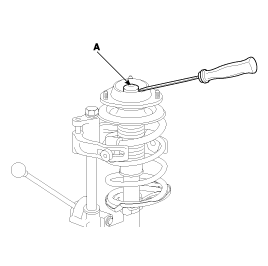
Remove the dust cover(A) with a flat-tipped (-) screw driver.

Open the dust cover and wipe off grease in the insulator.
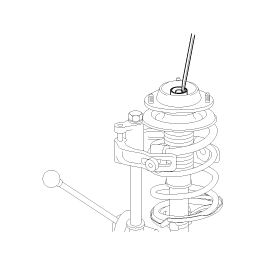
Using the special tool (09546-26000), compress the coil spring(A) until there is only a little tension of the spring on the strut.
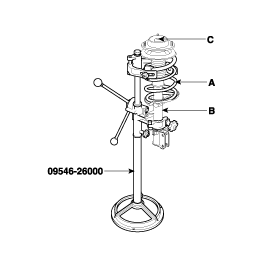
Remove the self-locking nut(C) from the strut assembly(B).
Remove the insulator, spring seat, coil spring and dust cover from the strut assembly.
Check the strut insulator bearing for wear or damage.
Check rubber parts for damage or deterioration.
Compress and extend the piston rod(A) and check that there is no abnormal resistance or unusual sound during operation.
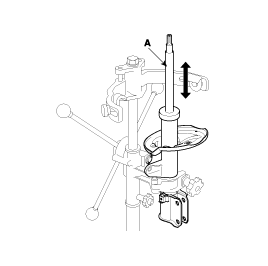
Install the spring lower pad(D) so that the protrusions(A) fit in the holes(C) in the spring lower seat(B).
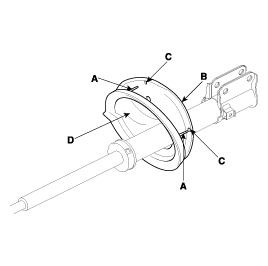
Compress coil spring using special tool (09546-26000).
Install compressed coil spring into shock absorber.
Indicated two identification color marks on the coil spring; one follows model option (see page SS-2) the other follows load classification according to the below.
Pay attention to distiuguish between the two marks and then install them.
Install the coil spring wth the idemtification mark directed toward the knuckle.
After fully extending the piston rod, install the spring upper seat and insulator assembly.
After seating the upper and lower ends of the coil spring(A) in the upper and lower spring seat grooves(B) correctly, tighten new self-locking nut temporarily.

Remove the special tool(09546-26000).
Tighten the self-locking nut to the specified torque.
Tightening torque
60~70 Nm(600~700 kgf·cm, 44.3~51.6 Ibf·ft)
Apply grease to the strut upper bearing and install the insulator cap.
When applying the grease, be careful so that it isn't smeared on the insulator rubber.
Fully extend the piston rod.
Drill a hole on the A section to remove gas from the cylinder.

The gas coming out is harmless, but be careful of chips that may fly when drilling.
Loosen the wheel nuts slightly.
Raise the front of the vehicle, and make sure it is securely supported.
Remove the front wheel and tire(A) from front hub(B).
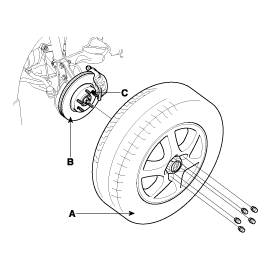
Bej careful not to damage the hub bolts(C) then remove the front wheel and tire(A).
Remove the brake hose bracket(B) and speed sensor cable mounting bolt(C) from the strut assembly(A).
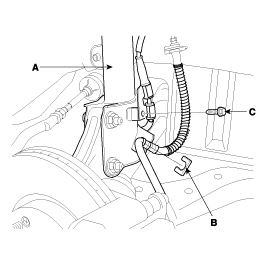
Remove the speed sensor cable mounting bolt(B) and speed sensor(A).
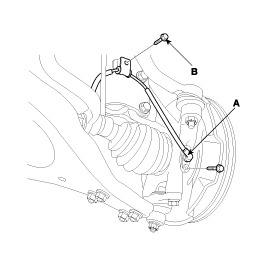
Remove the nut(B) from the stabilizer bar link(A).

Remove the strut upper mounting nuts(A).
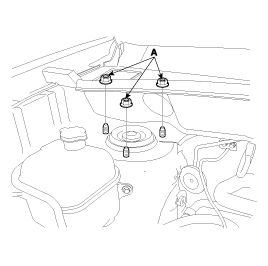
Remove the strut lower mounting bolts(A) and then remove the strut assembly(B).
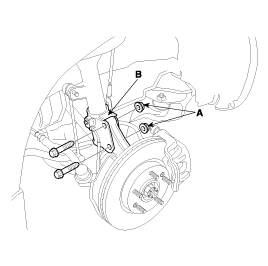
Install the strut assembly(B) and then install the strut lower mounting bolts(A).
Tightening torque
140~160 Nm (1400~1600 Kgf·cm, 103.3~118.0 Ibf·ft)

Install the strut upper mounting nuts(A).
Tightening torque
45~60 Nm (450~600 Kgf·cm, 33.2~44.3 Ibf·ft)

Install the nut(B) on the stabilizer bar link(A).
Tightening torque
100~120 Nm (1000~1200 Kgf·cm, 73.8~88.5 Ibf·ft)

Install the speed sensor cable mounting bolt(B) and speed sensor(A).
Tightening torque
7~11 Nm (70~110 Kgf·cm, 5.2~8.1 Ibf·ft)

Install the brake hose bracket(B) and speed sensor cable mounting bolt(C) on the strut assembly(A).
Tightening torque
7~11 Nm (70~110 Kgf·cm, 5.2~8.1 Ibf·ft)

Install the front wheel and tire(A) on the front hub(B).
Tightening torque
90~110 Nm (900~1100 Kgf·cm, 66.4~81.2 Ibf·ft)

Be careful not to damage the hub bolts(C) then install the front wheel and tire(A).